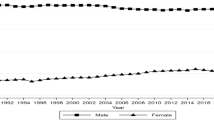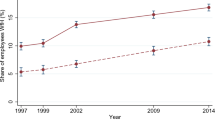Abstract
The distributional consequences of the recent economic crisis are still broadly unknown. While it is possible to speculate which groups are likely to be hardest-hit, detailed distributional studies are still largely backward-looking due to a lack of real-time microdata. This paper studies the distributional and fiscal implications of output changes in Germany 2008–2009, using data available prior to the economic downturn. We first estimate labor demand on 12 years of detailed, administrative matched employer-employee data. The distributional analysis is then conducted by transposing predicted employment effects of actual output shocks to household-level microdata. A scenario in which labor demand adjustments occur at the intensive margin (hour changes), close to the German experience, shows less severe effects on the income distribution compared to a situation where adjustments take place through massive layoffs. Adjustments at the intensive margin are also preferable from a fiscal point of view. In this context, we discuss the cushioning effect of the tax-benefit system and the conditions under which German-style work-sharing policies can be successful in other countries.
Similar content being viewed by others
References
Ahmed, V., & O’Donoghue, C. (2010). Global economic crisis and poverty in Pakistan. International Journal of Microsimulation, 3(1), 127–129.
Alda, H., Bender, S., & Gartner, H. (2005). European data watch: the linked employer-employee dataset created from the IAB establishment panel and the process-produced data of the IAB (LIAB). Schmollers Jahrbuch: Journal of Applied Social Science Studies, 125(2), 327–336.
Bach, H.-U., & Spitznagel, E. (2009). Betriebe zahlen mit—und haben was davon, IAB Kurzbericht No. 17.
Bellmann, L., Gerlach, K., & Meyer, W. (2008). Company-level pacts for employment. Journal of Economics and Statistics, 228(5–6), 533–553.
Bellmann, L., & Gerner, H.-D. (2011). Reversed roles? Wage and employment effects of the current crisis. Research in Labor Economics, 32, 181–206.
Bender, S., Haas, A., & Klose, C. (2000). The IAB employment subsample 1975–1995. Schmollers Jahrbuch: Journal of Applied Social Science Studies, 120(4), 649–662.
Bond, S., & Van Reenen, J. (2007). Microeconometric models of investment and employment. In J. J. Heckman & E. E. Leamer (Eds.), Handbook of econometrics, vol. 6, pp. 4417–4498. Amsterdam: Elsevier. Chapter 65.
Bourguignon, F., Bussolo, M., & Pereira da Silva, L. (2008). The impact of macroeconomic policies on poverty and income distribution: macro-micro evaluation techniques and tools. New York: Palgrave-Macmillan.
Bourguignon, F., Robilliard, A.-S., & Robinson, S. (2003). Representative versus real households in the macro-economic modelling of inequality. DIAL Document de Travail DT/2003-10.
Brechling, F., & O’Brien, P. (1967). Short-run employment functions in manufacturing industries: an international comparison. Review of Economics and Statistics, 49(3), 277–287.
Bresson, G., Kramarz, F., & Sevestre, P. (1992). Heterogeneous labor and the dynamics of aggregate labor demand: some estimations using panel data. Empirical Economics, 17(1), 153–168.
Cahuc, P., & Carcillo, S. (2011). Is short-time work a good method to keep unemployment down? IZA Discussion Paper No. 5430.
Card, D. (1986). Efficient contracts with costly adjustment: short-run employment determination for airline mechanics. The American Economic Review, 76(5), 1045–1071.
Collective Agreement Archive (2009). Tarifpolitik 2009 auf einen Blick, Informationen zur Tarifpolitik, Wirtschafts- und Sozialwissenschaftliches Institut der Hans-Böckler-Stiftung (WSI).
Diewert, W. E. (1971). An application of the shephard duality theorem: a generalized Leontief production function. Journal of Political Economy, 79(3), 481–507.
Diewert, W. E., & Wales, T. J. (1987). Flexible functional forms and global curvature conditions. Econometrica, 55(1), 43–68.
Dolls, M., Fuest, C., & Peichl, A. (2010). Automatic stabilizers and economic crisis: US vs. Europe, NBER Working paper 16275.
Eichhorst, W., Feil, M., & Marx, P. (2010). Crisis, what crisis? Patterns of adaptation in European labor markets. Applied Economics Quarterly Supplement, 56(61), 29–64.
Fay, J. A., & Medoff, J. L. (1985). Labor and output over the business cycle: some direct evidence. The American Economic Review, 75(4), 638–655.
Ferreira, F. H. G., Leite, P. G., Pereira da Silva, L.A., & Picchetti, P. (2008). Can the distributional impacts of macroeconomic shocks be predicted? A comparison of top-down macro-micro models with historical data for Brazil. In F. Bourguignon, M. Bussolo, & L. A. Pereira da Silva (Eds.), The impact of macroeconomic policies on poverty and income distribution: macro-micro evaluation techniques and tools, pp. 119–175. New York: Palgrave-Macmillan.
Freier, R., & Steiner, V. (2010). “Marginal employment” and the demand for heterogeneous labour: elasticity estimates from a multi-factor labour demand model for Germany. Applied Economics Letters, 17(12), 1177–1182.
Gupta, A., & Kapur, V. (2000). Microsimulation in government policy and forecasting. Amsterdam: North-Holland.
Hamermesh, D. S. (1986). The demand for labor in the long run. In O. Ashenfelter & R. Layard (Eds.), Handbook of labor economics, vol. 1, pp. 429–471. Amsterdam: Elsevier.
Hamermesh, D. S. (1993). Labor demand. Princeton: Princeton University Press.
Hijzen, A., & Venn, D. (2011). The role of short-time work schemes during the 2008–2009 recession, OECD Social, Employment and Migration Working Paper No. 115.
Hérault, N. (2010). Sequential linking of computable general equilibrium and microsimulation models: a comparison of behavioural and reweighting techniques. International Journal of Microsimulation, 3(1), 35–42.
Kölling, A. (2000). The IAB-establishment panel. Schmollers Jahrbuch: Journal of Applied Social Science Studies, 120(2), 291–300.
Möller, J. (2010). The German labor market response in the world recession: De-mystifying a miracle. Journal for Labour Market Research, 42(4), 325–336.
OECD (2010). Moving beyond the jobs crisis. In OECD (Ed.) OECD employment outlook: moving beyond the jobs crisis, pp. 15–102. Paris: OECD.
Peichl, A. (2009). The benefits and problems of linking micro and macro models: evidence from a flat tax analysis. Journal of Applied Economics, 12(2), 301–329.
Peichl, A., Schneider, H., & Siegloch, S. (2010). Documentation IZAΨMOD: The IZA Policy SImulation MODel. IZA discussion paper No. 4865.
Peichl, A., & Siegloch, S. (2010). Accounting for labor demand effects in structural labor supply models. IZA Discussion Paper No. 5350.
Robilliard, A.-S., Bourguignon, F., & Robinson, S. (2008). Examining the social impact of the Indonesian financial crisis using a macro-micro model. In F. Bourguignon, L. A. Pereira da Silva, & M. Bussolo (Eds.), The impact of macroeconomic policies on poverty and income distribution: macro-micro evaluation techniques and tools, pp. 93–118. New York: Palgrave-Macmillan.
von Wachter, T., & Bender, S. (2006). In the right place at the wrong time: the role of firms and luck in young workers’ careers. The American Economic Review, 96(5), 1679–1705.
Wagner, G. G., Frick, J. R., & Schupp, J. (2007). The German socio-economic panel study (SOEP)—scope, evolution and enhancements. Schmollers Jahrbuch: Journal of Applied Social Science Studies, 127(1), 139–169.
Zellner, A. (1962). An efficient method of estimating seemingly unrelated regressions and tests for aggregation bias. Journal of the American Statistical Association, 57(298), 348–368.
Author information
Authors and Affiliations
Corresponding author
Rights and permissions
About this article
Cite this article
Bargain, O., Immervoll, H., Peichl, A. et al. Distributional consequences of labor-demand shocks: the 2008–2009 recession in Germany. Int Tax Public Finance 19, 118–138 (2012). https://doi.org/10.1007/s10797-011-9177-9
Published:
Issue Date:
DOI: https://doi.org/10.1007/s10797-011-9177-9




